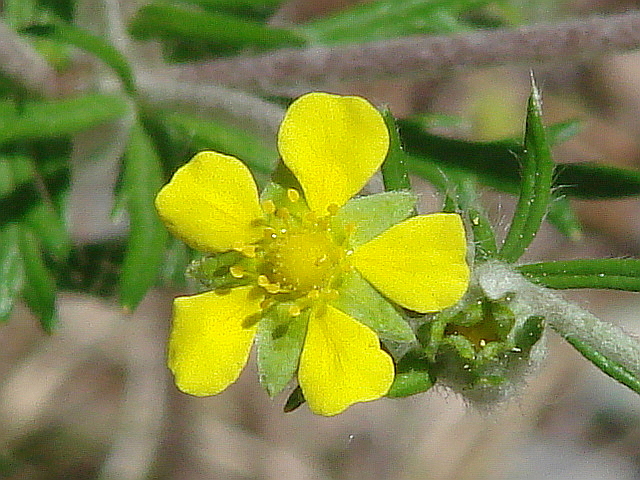Potentilla argentea
Potentilla norvegica
hoary cinquefoil, silver cinquefoil
Norwegian cinquefoil, rough cinquefoil
Leaves mainly cauline, 5-10 per stem, palmately divided, the leaflets 5, 1-2 cm. long, oblanceolate, with coarse serrate teeth over half way to the mid-vein;
stipules lanceolate, entire, 4-8 mm. long.
Leaves alternate, mainly cauline;
stipules well-developed, ovate, usually strongly toothed;
leaflets usually 3, broadly ovate to obovate below to narrowly oblong above, 3-6 cm. long, serrate with rounded teeth, pubescent.
Inflorescence open, branched, many-flowered, leafy-bracteate;
calyx 4-6 mm. broad, silky, the 5 lobes ovate-lanceolate, 2-3 mm. long, alternating with linear, shorter bracteoles;
petals 5, yellow, obovate with a wedge-shaped base, equaling the sepals;
stamens 20;
pistils numerous, the styles thickened and glandular at the base, tapered upward, attached to the end of the achene.
Inflorescence a rather compact cyme with a long peduncle;
calyx 7-11 mm. broad, the 5 sepals broadly lanceolate, erect, the 5 bracteoles lanceolate and about equal in length to the sepals;
petals yellow, broadly obovate, slightly shorter than the sepals;
stamens usually 20;
pistils numerous;
style terminal, thickened basally.
Achene 0.6-0.8 mm. long, the same length as the style.
Achenes light brown, 1.0-1.3 mm. long ovate, flattened.
Potentilla argentea
Potentilla norvegica
- Local floras:
BC,
OR,
WA
- Local Web sites:
Flora NW,
PNW Herbaria
WildflowerSearch
iNaturalist (observations)
USDA Plants Database
- LBJ Wildflower Center
- SEINet
- Plants of the World Online
- Encyclopedia of Life
- Wikipedia
- Google Image Search
- Local floras:
BC,
CA,
OR,
WA
- Local Web sites:
CalFlora,
CalPhotos,
Flora NW,
PNW Herbaria
WildflowerSearch
iNaturalist (observations)
USDA Plants Database
- LBJ Wildflower Center
- SEINet
- Plants of the World Online
- Encyclopedia of Life
- Wikipedia
- Google Image Search



